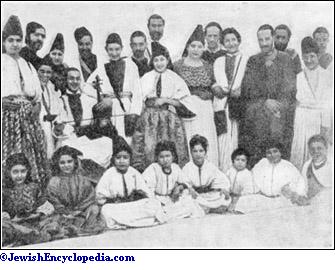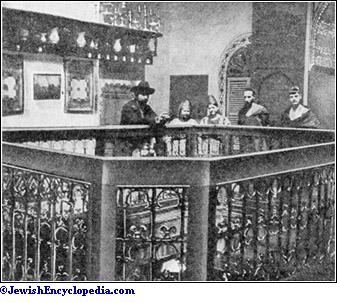FEZ ( Arabic, Fas):
Arabic, Fas):
Capital of the province of Fez in the sultanate of Morocco; built in the year 808 by Imam Idris II., who founded in Morocco the first Shiite state. A small wadi, known under various names, divides the city into two parts, Old Fez, containing the palace and the "Mellah" or Jewish quarter, and New Fez, which contains the bulk of the modern city. Idris, finding that his nomadic subjects were thoroughly averse to a town life, colonized his new capital with 8,000 Andalusians and a number of Jews; the latter must have been numerous even at this early date, since he sought their aid in his rebellion against the ruling king, Muhadi. The Jews received from Idris a special quarter, the Mellah, and thenceforth paid a special tax of 30,000 denarii annually in lieu of military service. A similartax exists in Morocco to the present day. The Mellah has high walls and a single gate; it is very dirty and unsanitary. First mention of the Jews of Fez is found in Judah ibn Koreish's letter on Targum study, which was addressed to them about 900. As several teshubot show, they communicated with the Geonim. The civil and political liberties of the Jews were restricted by the Pact of Omar, and after the capture of Fez by Yusuf ibn Tashfin in 1070 these restrictions were rigidly enforced over all North Africa. In 1145 Fez fell into the hands of 'Abd al-Mu'min, the follower of the fanatical Mohammed ibn Tumart, and an era of persecution began. On the capture of Morocco in the following year the Jews were given the alternative of conversion or banishment. Many fled to Italy, Spain, and Palestine, R. Jehuda b. Abun b. Abbas among them; the majority adopted the semblance of Islamism.
It was during this time that the martyrdom is recorded of Judah ha-Kohen ibn Susan. From 1152 to 1165 Maimonides' father, with his family, sought refuge in Fez from the persecutions at Cordova, attracted thither by the scholarship of Judah ha-Kohen. In 1275 the mob attacked the Mellah, and forty Jews were slain, after which Moors were forbidden to enter the Jewish quarter. The emir laid out New Fez, where the Jews were permitted to dwell, and where they still reside. With the inauguration of the Spanish persecutions of 1391 the influx of Jews increased until, according to Bakuwi, a geographer of the fifteenth century, they formed a majority of the population. Under the merciful government of Maula Shaikh fugitives from Spain found a resting-place here. Some years later a great persecution took place, accompanied by pillage and massacre, the king and his favorite Aaron falling victims to the fury of the mob. But the next king allowed the pseudo-Mohammedans to return to their faith under certain conditions, which are still in force: they were forbidden to wear leather shoes, to ride on horseback through the city, or to carry arms. In addition to these restrictions the earlier decree of Manṣur ordering that Jews should wear black mantles and Jewesses yellow mantles and veils, was enforced.

At the time of the expulsion from Spain (1492) many Jews fled to Fez, but were expelled by the natives, who feared an increase in the price of provisions. Some of the refugees died of starvation; the rest were enslaved by the population, but were later freed by a decree of the governor. Abu Sa'id III. set apart for them a large district in the new city. The Arabic language, which had hitherto been spoken by the Jews, was now replaced by Spanish. At the beginning of the sixteenth century the Jewish population, according to Bernaldes, amounted to 10,000, according to Leo Africanus to 5,000, according to Mendoça to 1,000. In the first quarter of the century the Jews had an influential statesman,Shumel al-Barensi, minister of the emir Sa'id al-Watas, by whom several Jews were admitted to the royal court. In the struggle between the Merinids and the Sherifs a Spanish Jew, Samuel Alvalensi, was a political partizan of the former. The Jews of Fez also took part in the movement connected with the person of David Reubeni, who appears to have been cheated in a transaction entered into by correspondence from Cairo with R. Cohen, a writer of Fez, in 1523. In 1532 the Franciscan Andre of Spoleto had a public disputation with the Jews, but being unable to make any conversions, he committed suicide.
Because of the severe persecutions under Mulai Mohammed many Jewish captives were brought to Fez and there ransomed by the community. After the defeat of the Portuguese at Al-Ḳaṣr in 1578, many Portuguese noblemen were sold as slaves to the Jews in Fez, who ransomed and treated with kindness their former oppressors. In 1670 Fez was the asylum of the Jews of Sus, expelled by Mulai Arshid. In the reign of his successor, Ismail, the Jews suffered greatly because of high taxes. When in 1790 Mulai Sidi Mohammed was slain through the sedition of his son Mulai Yazid, the latter persecuted the Jews because they had not helped him against his father. Houses and synagogues were pillaged and the bones of the dead disinterred. The condition of the Jewish community did not improve in the nineteenth century. In 1834 a Jewish girl, a daughter of Sol Hachuel, was a martyr to her faith, preferring death to becoming the bride of the sultan. Her tomb became a place of pilgrimage.
Out of a total estimated at from 100,000 to 150,000 the Jewish population of Fez a few years ago was 9,000 according to Balbi, 2,500 according to Mordtmann, 8,000 according to Richardson, 10,000 according to Horowitz, and 30,000 according to Meakin, while the Alliance Israélite Universelle placed the number at 12,000. Over 2,000 died recently in a typhus epidemic, and their number is now estimated at 8,000, most of whom live in New Fez. There are nineteen synagogues, many of which possess very old scrolls of the Law. They are mostly named after their founders, as Keneset Jonathan Severo, or Keneset Rabbi Judah Aṭṭar. Fez possesses a Talmud Torah attended by about 500 pupils, and two schools founded by the Alliance in 1883 and 1899, attended respectively by 103 boys and 80 girls. A synod of six rabbis whose salaries are paid from the meat-tax takes charge of the spiritual interests of the Jews. There are no Jewish government officials. The Jews of Fez are by preference shoemakers and grocers. The richer are money-lenders. The men wear cork-screw curls behind their ears, shave the head, and leave a pig-tail pendent from the top. The women, who are partly secluded, wear after marriage a black wig covered with a kerchief. Women in mourning wear a red head-kerchief, leave the feet bare, and wear around the mouth part of the winding-sheet of the dead. Early marriages are the rule.

Fez has produced several writers. Prominent among them are the grammarians Dunash ibn Labrat, and Judah b. David Ḥayyuj; Alfasi, and the Karaite Moses Alfasi and members of the Azulai family, authors of various bibliographies of Jewish literature. Ḥayyim Azulai emigrated from Castile to Fez in 1492. Toward 1630 Vidal Ẓarfati, author of "Ẓuf Debash," was chief rabbi of Fez, as was (c. 1755) Jacob ben Ẓur, author of "Mishpaṭ Ẓedakah." Fifteen years later the chief rabbi was Elijah Ẓarfati. A former rabbi of Fez, Jacob ben Na'im, became chief rabbi of Leghorn, where he died in 1800.
- Ersch and Gruber, Encyc. section i., parts 43-44, pp. 434 et seq.;
- Dozy, Gesch. der Mauren, i. 294 et seq.;
- Grätz, Gesch. vi. 111, 156 et seq.; ix. 12, 524;
- Marcus Fischer, Toledot Yeshurun, Prague, 1817;
- Ibn Verga, Shebeṭ Yehudah, No. 30;
- Neubauer, Medieval Jewish Chronicles, i. 57, 106, 112; ii. 179, 189, 191, 218;
- Josef ha-Kohen, Sefer Dibre ha-Yamim, transl. by Bialloblotzky, ii., No. 1075, London, 1835;
- Samuel Romanelli, Massa', ed. Schiller-Szinessy, pp. 61, 63;
- Zedner, Auswahl Histor. Stücke, pp. 96, 220 et seq.;
- Kayserling, Gesch. der Juden in Portugal, pp. 136, 213, 260;
- Moses Mendelssohn, Gesammelte Schriften, iii. 212;
- Notices et Extraits des Manuscripts du Roi, ii. 414;
- Leo Africanus, Descriptio Africœ;
- Richardson, Travels in Morocco, ii. 139 et seq., London, 1860;
- Rohlfs, Erster Aufenthalt in Marokko, p. 184;
- Pietsch, Marokko, p. 175;
- Conring, Marocco, p. 185;
- Horowitz, Marokko, p. 188;
- Bulletin All. Isr. 1900, p. 112; 1901, pp. 72, 115;
- Z. D. M. G. xviii. 329;
- R. E. J. xxxv. 306, xxxvii. 120, xxxix. 315;
- J. Q. R. iv. 369;
- Jahresbericht des Breslauer Seminars, 1894, p. 31;
- Steinschneider, Cat. Bodl. cols. 837, 856, 897, 1087, 1149, 1301, 1784, 2695;
- Poznanski, in Ha-Ẓefirah, 1903, Nos. 3-5, 7, 10, 12, 17, 25.

